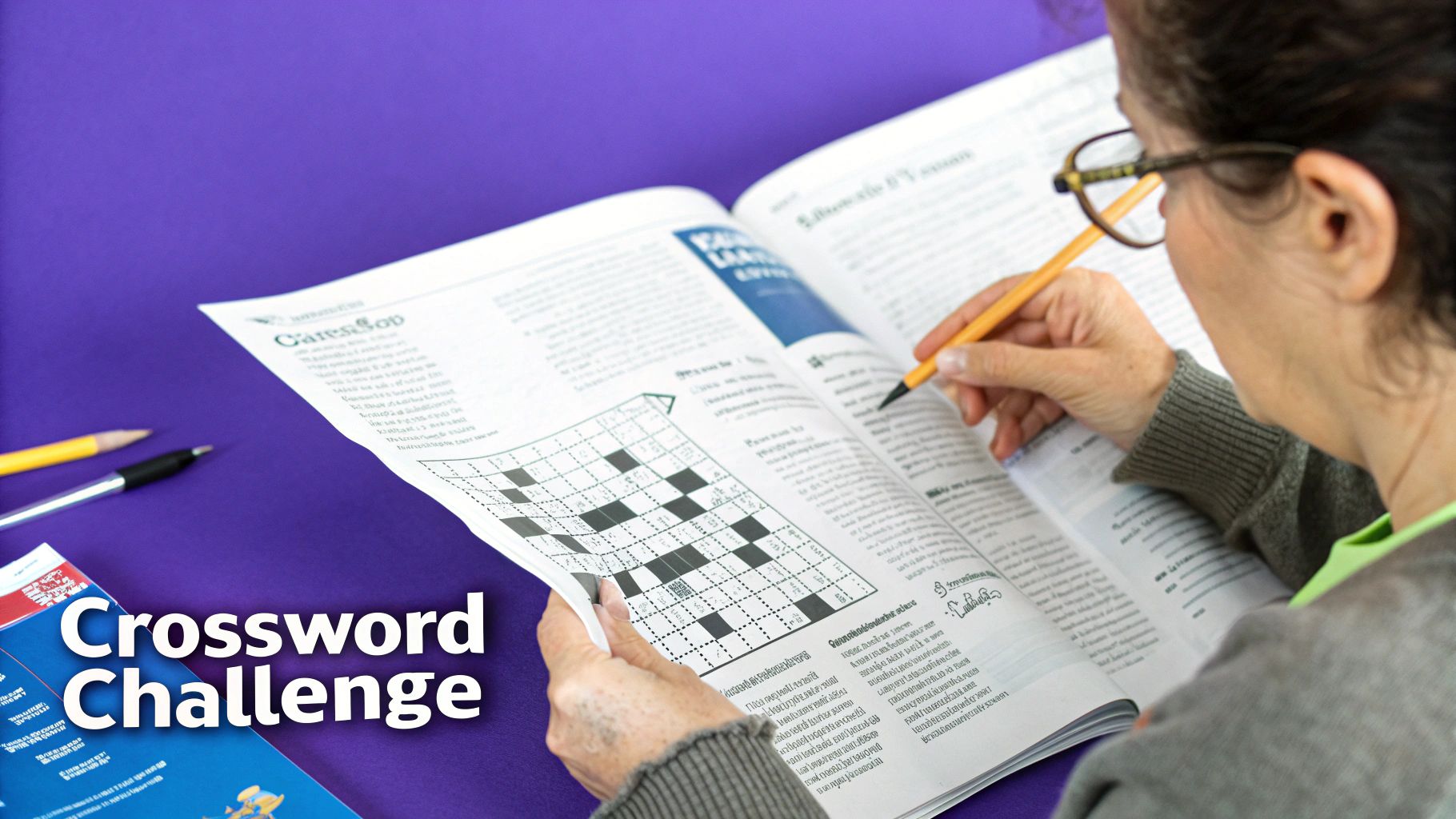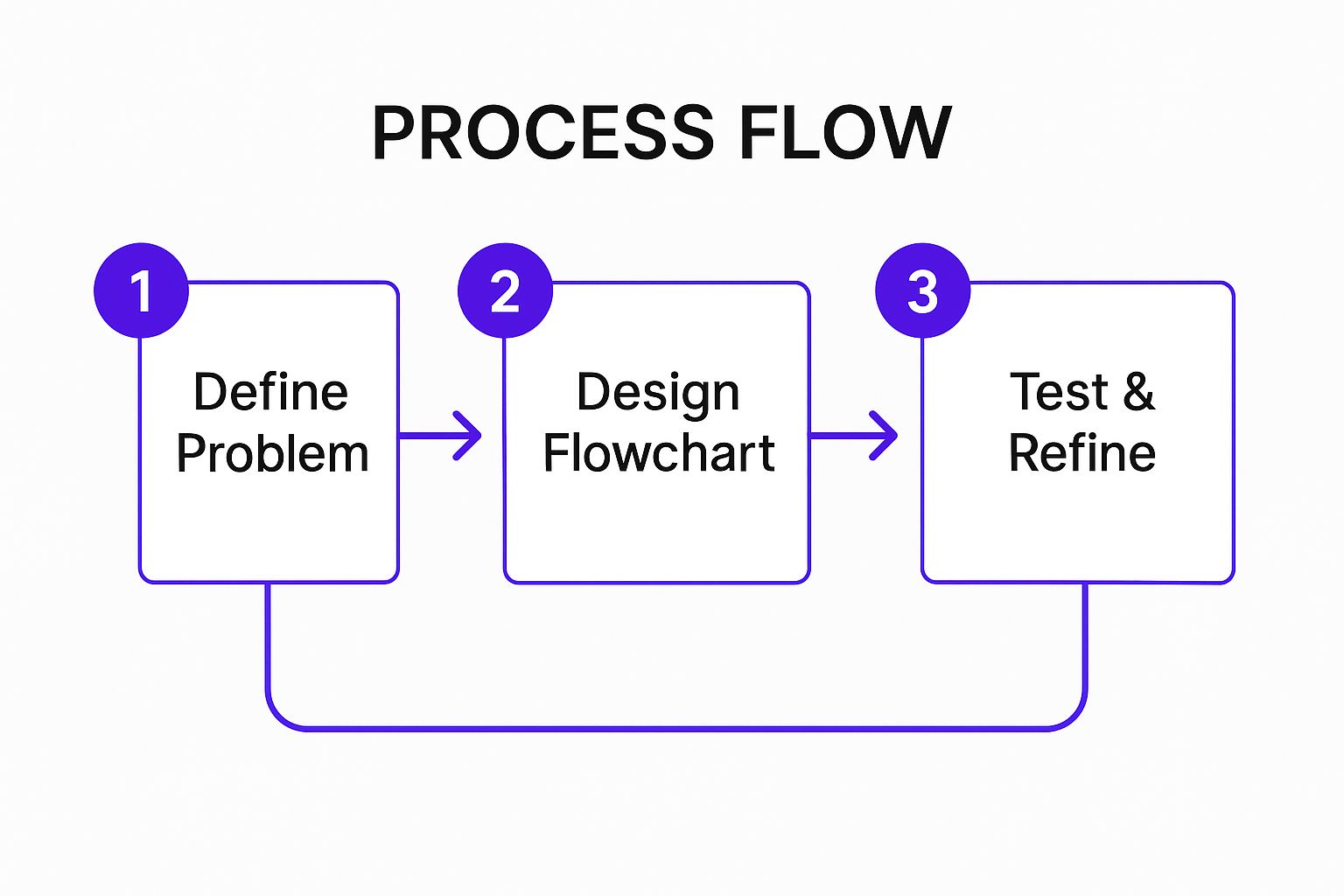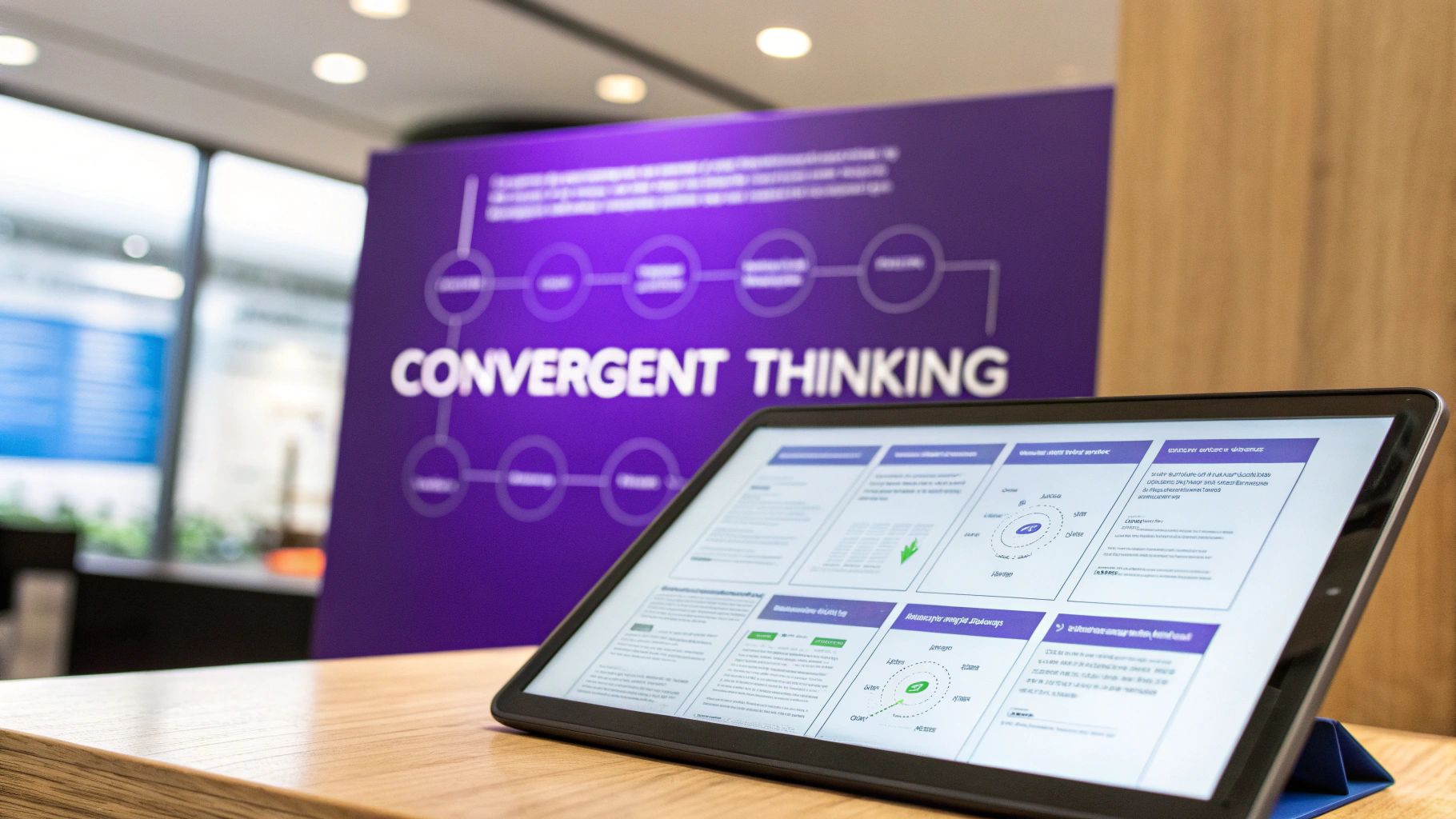In the world of remote collaboration, generating endless ideas is only half the battle. The real challenge is sifting through the noise to find the single best solution. This is where convergent thinking comes in-the structured, logical process of evaluating options to arrive at a definitive answer. While divergent thinking opens up possibilities, convergent thinking provides the focus needed to turn those possibilities into actionable results.
For remote teams using tools like Bulby, mastering this skill is crucial for efficient decision-making and innovation. This article moves beyond theory to provide concrete convergent thinking examples. We will break down each method and show you how to adapt it to help your team find clarity and make impactful choices, no matter where you are.
You will learn how to apply structured thinking to everyday remote work challenges, from troubleshooting technical problems to analyzing complex case studies. The goal is to equip your team with practical, replicable strategies for evaluating ideas, solving problems, and moving from a wide-ranging brainstorm to a single, powerful breakthrough. We'll explore specific tactics for standardized debate, algorithm design, and even logic puzzles, demonstrating how these exercises build the mental muscles required for sharp, effective decision-making.
1. Multiple Choice Tests
Multiple choice tests are the quintessential exercise in convergent thinking. They provide a question or problem along with a predefined set of possible answers. The goal is to apply logic, knowledge, and deduction to identify the single best solution among the options. This format forces a focused, analytical approach rather than open-ended brainstorming.

From standardized academic tests like the SAT to professional certifications like the Project Management Professional (PMP) exam, this method is a global standard for evaluating knowledge precisely. It measures one's ability to quickly analyze information and converge on a correct answer.
Strategic Analysis
Multiple choice questions are powerful because they create a controlled decision-making environment. This structure is ideal for assessing baseline knowledge or ensuring alignment on factual information. The key is that the "right" answer already exists; the challenge is to find it efficiently.
Key Insight: This format isn't about creating something new. It's about accurately identifying the best existing option, a core skill in quality assurance, diagnostics, and data validation.
Actionable Takeaways for Remote Teams
Remote teams can adapt this format in various ways to drive clarity and make decisions.
- Knowledge Checks: Use multiple choice quizzes in tools like Bulby to ensure team members understand new project requirements, software updates, or company policies. This provides instant, measurable feedback on comprehension.
- Quick Polls for Decision-Making: When a team needs to make a quick, constrained choice, frame it as a multiple choice question. For example: "Which of these three cloud providers best meets our budget and security needs (A, B, or C)?"
- Prioritization Exercises: List potential features or tasks as options and have the team vote on the top priority. This is a simple but effective example of using convergent thinking to focus efforts.
2. Mathematical Problem Solving
Mathematical problem solving is a pure form of convergent thinking. It requires applying established formulas, logical rules, and systematic procedures to work toward a single, verifiable correct answer. Unlike creative brainstorming, the path to the solution is often linear and governed by the strict principles of mathematics.
From calculating compound interest in finance to engineering stress calculations for a bridge, this type of thinking is essential for precision and accuracy. The process involves breaking down a problem, applying the correct operations, and converging on a definitive numerical result. The structured nature of math makes it a perfect example of convergent thinking in action.
Strategic Analysis
The power of mathematical problem solving lies in its objectivity. There are no opinions or gray areas; the answer is either right or wrong based on a universally accepted system of logic. This makes it an invaluable tool for any scenario requiring unambiguous, data-driven conclusions. Learn more about the core principles behind convergent thinking and its applications.
Key Insight: This method eliminates ambiguity. It's about applying a rigorous, repeatable process to achieve a predictable and accurate outcome, which is critical for financial modeling, resource allocation, and technical diagnostics.
Actionable Takeaways for Remote Teams
Remote teams can leverage the principles of mathematical problem solving to bring clarity to complex business decisions.
- Financial Forecasting: Use spreadsheet models with clear formulas to project revenue, costs, and profitability. This forces the team to converge on specific numbers rather than vague estimates.
- A/B Testing Analysis: When evaluating A/B test results, use statistical significance calculations to make a definitive decision. This removes guesswork and lets the data dictate the correct path forward.
- Resource Allocation: Frame resource planning as a mathematical problem. For example: "Given X budget and Y hours, what is the optimal distribution of resources across these three projects to maximize ROI?" This structures the discussion around a single, correct answer.
3. Crossword Puzzles
Crossword puzzles are a classic example of convergent thinking in action. They provide a series of interlocking clues, each requiring a single correct answer. Solvers must use vocabulary, logic, and deductive reasoning to find the specific word that fits both the clue's definition and the spatial constraints of the intersecting letters.

From the famous New York Times daily puzzle to themed educational crosswords, this format trains the brain to filter through possibilities and converge on one precise solution. The puzzle's structure provides immediate feedback, as incorrect answers prevent other words from fitting correctly.
Strategic Analysis
Crossword puzzles excel at demonstrating how constraints can guide problem-solving. Each clue has one right answer, and the grid’s interlocking nature creates a self-correcting system. This makes it an ideal exercise for honing analytical skills and attention to detail within a defined framework.
Key Insight: The power of crosswords lies in using multiple, intersecting data points (the clues and crossing letters) to verify a single solution. This mimics the process of cross-referencing information to confirm a hypothesis in business or technical troubleshooting.
Actionable Takeaways for Remote Teams
Remote teams can use the principles of crossword puzzles to sharpen their problem-solving and communication skills.
- Refining Project Requirements: Frame project specifications like a crossword clue. For example, instead of saying "build a fast login page," define it as: "Develop a user authentication page (5 letters) that loads in under 2 seconds (4 letters)." This forces precision.
- Troubleshooting Technical Issues: When debugging, create a "problem grid" where each symptom is a clue. The solution to one clue (e.g., identifying a faulty API call) provides letters that help solve another, leading the team to the root cause.
- Team-Building Exercises: Use a custom crossword puzzle in a tool like Bulby as a fun onboarding or training activity. Fill it with company jargon, team member names, and project codenames to reinforce shared knowledge in an engaging way.
4. Logic Puzzles and Sudoku
Logic puzzles like Sudoku are pure exercises in convergent thinking. They present a closed system with a clear set of rules and constraints, requiring the user to apply systematic deduction to arrive at a single, correct solution. The process involves methodically eliminating impossible options until only the correct answer remains for each empty space.

From the classic 9×9 Sudoku grid to more complex logic grid puzzles, these activities train the brain to work within a defined framework. Unlike creative brainstorming, the goal is not to invent a solution but to uncover the one that already exists by following a logical pathway. This skill is a prime example of convergent thinking in action.
Strategic Analysis
Logic puzzles excel at strengthening deductive reasoning within a constrained environment. The solver must work methodically, understanding that each decision impacts the entire system. This simulates complex problem-solving scenarios where variables are interdependent and one wrong step can invalidate the entire outcome.
Key Insight: This type of thinking is crucial for tasks like debugging code, financial auditing, or root cause analysis. It teaches a systematic process of elimination and verification to find the single point of failure or truth.
Actionable Takeaways for Remote Teams
Remote teams can use the principles of logic puzzles to enhance problem-solving and analytical skills.
- Systematic Troubleshooting: When a bug or issue arises, create a "logic grid" listing potential causes against known symptoms. Team members can work together to systematically test and eliminate variables until the root cause is identified.
- Constraint-Based Planning: For project planning, define the non-negotiable constraints (budget, timeline, resources) first. Use these as the "rules of the game" to logically deduce the most viable project pathway, just as one would solve a Sudoku.
- Team-Building Exercises: Use online logic puzzles or virtual escape rooms as team-building activities. These fun exercises sharpen the team's collective convergent thinking skills in a low-stakes environment.
5. Case Study Analysis
Case study analysis is a structured, convergent thinking exercise where a real-world scenario is examined to find the most effective solution or conclusion. Participants must sift through details, identify the core problem, and apply established frameworks to arrive at a logical, evidence-based recommendation. This method forces a focused synthesis of complex information.
Popularized by institutions like Harvard Business School, this method is a staple in business, law, and medical training. It's used to analyze everything from engineering failures to marketing campaign successes, teaching professionals how to move from a complex problem to a single, defensible conclusion.
Strategic Analysis
The power of case study analysis lies in its simulation of real-world decision-making under constraints. It trains the mind to filter out noise, apply relevant models, and justify a single course of action from many possibilities. This is one of the most practical convergent thinking examples for developing strategic problem-solving skills.
Key Insight: This method isn't about invention but about application. The challenge is to apply existing principles and data correctly to solve a predefined problem, a crucial skill for strategic planning and crisis management.
Actionable Takeaways for Remote Teams
Remote teams can use the case study method to sharpen their analytical skills and align on complex decisions.
- Post-Project Retrospectives: Frame a completed project (successful or not) as a case study. Have the team analyze the timeline, data, and decisions to identify the single most critical factor for the outcome.
- Competitive Analysis: Create a case study based on a competitor's recent product launch or marketing campaign. Task the team with analyzing it to determine the most effective strategy to counter it.
- Strategic Planning Workshops: Use a hypothetical business scenario relevant to your industry. In a tool like Bulby, guide the team to converge on the single best strategic response, documenting the evidence for their choice.
6. Troubleshooting Technical Problems
Troubleshooting is a classic example of convergent thinking in action. It's a systematic process of deduction used to diagnose and resolve a problem by methodically eliminating potential causes. This approach starts with a broad set of possibilities and narrows them down until the single root cause is identified and a precise solution can be applied.
From an IT professional debugging a network failure to a software developer tracing a bug in code, troubleshooting relies on logic and evidence. It requires moving from a state of uncertainty to a definitive answer by testing hypotheses one by one. This structured process is essential for maintaining complex systems and is a core skill in technical fields.
Strategic Analysis
Troubleshooting forces a logical, step-by-step funneling of information. Rather than guessing randomly, it relies on a structured approach to isolate variables and test assumptions against reality. This discipline prevents wasted effort and ensures that solutions are based on evidence, not intuition. It's a foundational skill for any team managing technology or complex processes.
Key Insight: This process is about deconstruction and elimination. The solution already exists within the system's logic; the goal is to systematically remove noise and false leads until only the core problem remains.
Actionable Takeaways for Remote Teams
Remote teams managing software, infrastructure, or digital products can integrate troubleshooting principles into their daily workflows. A guide on a structured problem-solving approach can provide more depth on these methods.
- Create Standard Operating Procedures (SOPs): Develop documented troubleshooting guides for common issues. This ensures anyone on the team can start the diagnostic process correctly, even without direct supervision.
- Isolate Variables in A/B Tests: When a feature or marketing campaign isn't performing, use a troubleshooting mindset. Change only one variable at a time in your tests to accurately identify what is impacting performance.
- Use a "5 Whys" Template: When a problem occurs, use a shared document or a Bulby template to ask "Why?" five times. This forces the team to drill down past surface-level symptoms to find the root cause collaboratively.
7. Standardized Debate Formats
Standardized debate formats, like Lincoln-Douglas or Policy Debate, are structured exercises in convergent thinking. Participants are given a resolution and must build a logical case, using evidence and reasoning, to arrive at a single, persuasive conclusion. The goal is to systematically deconstruct opposing views and funnel all arguments toward a definitive judgment.
From high school competitions organized by the National Speech & Debate Association to public forums like the Intelligence Squared series, these formats are designed to test one's ability to process complex information and converge on the most defensible position under pressure.
Strategic Analysis
Debates are a powerful training ground for convergent thinking because they demand a disciplined approach to argumentation. Within strict time limits and rules, the debater must identify the strongest evidence and most logical points to build an airtight case. This process mirrors real-world business decisions where teams must analyze competing data to land on a single strategic direction.
Key Insight: The rigid structure of a debate forces participants to move beyond brainstorming and instead focus on synthesis and justification, a critical skill for making high-stakes, evidence-based decisions.
Actionable Takeaways for Remote Teams
Remote teams can leverage debate principles to sharpen their decision-making processes and ensure all angles of an issue are explored.
- Formalize a 'Pro/Con' Discussion: Before a major decision, assign team members to formally argue for and against a proposal in a timed discussion. This structured approach ensures both sides are heard thoroughly before converging on a solution.
- Run 'Red Team/Blue Team' Scenarios: To pressure-test a new strategy, create a "red team" to find flaws and a "blue team" to defend it. This simulates a debate and helps identify weaknesses before launch.
- Evidence-Based Prioritization Meetings: Require team members to present evidence-backed arguments for why their proposed feature should be prioritized. This turns subjective opinion into a structured, convergent discussion based on data.
8. Algorithm Design and Flowcharting
Algorithm design and flowcharting are classic convergent thinking exercises focused on creating a step-by-step procedure to solve a specific problem. This process involves breaking down a complex challenge into a logical sequence, defining decision points, and converging on the most efficient pathway from a given input to a desired output. It is the bedrock of computer programming, process automation, and systematic problem-solving.
From software development algorithms that sort user data to business process flowcharts for handling customer service inquiries, this method provides a clear, visual map to a single correct outcome. It forces a team to think logically and sequentially to eliminate ambiguity and find the optimal solution.
Strategic Analysis
The power of algorithm design is in its demand for precision. By mapping out every possible step and decision point, teams can identify bottlenecks, inefficiencies, and potential failure points before they occur. This structured approach is essential for any task where consistency and reliability are non-negotiable, like in medical diagnostic protocols or manufacturing workflows.
Key Insight: This method transforms abstract goals into concrete, executable plans. It's a prime example of convergent thinking because it systematically narrows down infinite possibilities into one replicable and optimized procedure.
Actionable Takeaways for Remote Teams
Remote teams can use flowcharting to standardize processes and ensure everyone follows the same playbook, regardless of their location.
- Standard Operating Procedures (SOPs): Use tools like Miro or Lucidchart to create visual flowcharts for common tasks, such as new employee onboarding or submitting expense reports. This provides a single source of truth for all team members.
- Troubleshooting Guides: Develop decision-tree flowcharts to help team members solve common technical or project-related issues independently. For example: "If the app crashes, does clearing the cache fix it? Yes/No."
- Process Optimization: Before automating a workflow, map the current process as a flowchart. The team can then analyze it to eliminate redundant steps and converge on a more streamlined, efficient design.
10. Logic Puzzles and Riddles
Logic puzzles and riddles are classic convergent thinking exercises that challenge you to find a single correct solution based on a set of given constraints. They require careful deduction, systematic elimination, and the ability to connect seemingly disparate pieces of information. The goal is to follow a logical path to arrive at a definite, verifiable answer.
This infographic outlines the basic process flow for solving a structured logic puzzle.

By visualizing the steps, the process moves from broad constraints to a single, confirmed solution.
Strategic Analysis
The power of logic puzzles lies in their ability to train the brain to work systematically within a closed system of rules. Unlike open-ended problems, the answer is already embedded within the puzzle's framework. This makes them excellent tools for sharpening analytical skills and improving attention to detail, which are crucial for debugging code, troubleshooting technical issues, or conducting financial audits.
Key Insight: This type of problem-solving strengthens one's ability to identify and work with constraints, a vital skill for project management where resources, time, and scope are always finite.
Actionable Takeaways for Remote Teams
Remote teams can use the principles of logic puzzles to enhance problem-solving and decision-making.
- Constraint-Based Problem Solving: When facing a complex issue, frame it like a logic puzzle. Start by listing all known constraints (e.g., budget, timeline, tech stack). This narrows the field of potential solutions and focuses the team's efforts.
- Team-Building Exercises: Use quick logic riddles as warm-ups in virtual meetings. Tools like Bulby can facilitate these short, engaging activities to get everyone's analytical mind working before diving into more complex topics.
- Root Cause Analysis: Structure a root cause analysis session by asking the team to "solve the riddle" of a bug or process failure. Have them deduce the single point of origin by eliminating possibilities based on available data and evidence.
Top 10 Convergent Thinking Examples Comparison
| Exercise Type | Implementation Complexity 🔄 | Resource Requirements ⚡ | Expected Outcomes 📊 | Ideal Use Cases 💡 | Key Advantages ⭐ |
|---|---|---|---|---|---|
| Multiple Choice Tests | Low – standardized format, easy to deploy | Moderate – test creation, grading software | Objective knowledge assessment, quick scoring | Large-scale assessments, hiring, certification | Scalable, unbiased scoring, efficient grading |
| Mathematical Problem Solving | Moderate – requires problem design | Low to moderate – basic tools, mathematical knowledge | Strengthened logical/math skills, precise solutions | Education, real-world quantitative problems | Develops reasoning, clear correctness feedback |
| Crossword Puzzles | Moderate – puzzle construction is specialized | Low – paper or digital platform | Enhanced vocabulary, memory, and lateral thinking | Leisure, vocabulary building, cognitive maintenance | Vocabulary growth, mental agility, low-cost |
| Logic Puzzles and Sudoku | Moderate – requires designing constraints | Low – paper or app-based | Improved logic, executive function, and focus | Brain training, entertainment, cognitive skill building | Pure logic focus, no special knowledge needed |
| Case Study Analysis | High – complex scenario creation | High – detailed material and facilitation | Practical decision-making and critical thinking | Professional education (business, law, medicine) | Bridges theory and practice, develops analytic skills |
| Troubleshooting Technical Problems | High – domain-specific, step-by-step process | High – technical tools and knowledge | Root cause diagnosis and resolution | IT, engineering, medical diagnostics | Structured analysis, practical applicability |
| Standardized Debate Formats | High – requires preparation, research | High – training, materials, adjudicators | Enhanced critical thinking, communication skills | Education, competitive debating | Develops research, argumentation, public speaking |
| Algorithm Design and Flowcharting | Moderate to high – systematic procedure design | Moderate – flowchart tools, analytical skills | Clear procedural understanding, problem breakdown | Programming, process optimization | Visual clarity, reusable procedural solutions |
Converge with Confidence: Your Next Steps
We've explored a wide range of convergent thinking examples, from the analytical rigor of troubleshooting technical problems to the structured logic of Sudoku puzzles. Each example demonstrates a fundamental truth: innovation isn't just about generating endless ideas; it's about systematically finding the best idea and refining it into a workable solution.
The journey from a sea of possibilities to a single, powerful course of action is where remote teams often struggle. The examples in this article, such as case study analysis and algorithm design, provide a practical toolkit for navigating this critical phase. They show that convergent thinking is a skill, not an innate talent. It's a muscle that strengthens with deliberate practice.
Key Takeaways for Your Team
The core lesson is that structure is creativity's best friend. Unfocused brainstorming sessions lead to fatigue and inaction. By integrating structured convergence, you bring clarity and purpose to your team's collaborative efforts.
- Balance is Essential: The most effective teams fluidly transition between divergent brainstorming (going wide) and convergent decision-making (going deep). One cannot exist effectively without the other.
- Process Over Preference: Convergent thinking replaces subjective opinions with objective criteria. Using frameworks like a decision matrix or a pros-and-cons list ensures that choices are based on logic and shared goals, not just the loudest voice in the room.
- Action is the Goal: The ultimate purpose of convergence is to drive action. Each exercise we covered, from standardized debates to mathematical problem-solving, is designed to produce a clear outcome, a decision, or a defined next step.
Your Action Plan for Mastering Convergence
Mastering these concepts transforms your team's ability to execute. By embedding these practices into your regular workflows, you build a culture of decisiveness and focused execution. This is how high-performing teams turn ambitious goals into tangible results.
Start small. Don't try to implement every technique at once. Choose one or two convergent thinking examples that align with your team's current challenges.
- Select a Relevant Exercise: If your team is struggling with feature prioritization, try a simplified case study analysis for your next planning session. If technical solutions are ambiguous, use a flowcharting exercise to map out potential paths.
- Define Clear Criteria: Before you start narrowing down options, agree on the evaluation criteria as a team. What does "best" mean for this specific problem? Is it cost-effectiveness, speed to market, or user impact?
- Use a Facilitation Tool: For remote and hybrid teams, a digital platform is crucial for keeping the process organized and inclusive. This ensures everyone can contribute equally and that the decision-making process is transparent.
By consistently applying these structured methods, you demystify the decision-making process. You empower your team to move forward with alignment and confidence, ensuring that every great idea has a clear path to becoming a reality.
Ready to turn your team's brilliant ideas into actionable strategies? Bulby provides the structured environment your remote team needs to master both divergent and convergent thinking. Try Bulby today to facilitate more effective workshops and make decisions with clarity and confidence.

